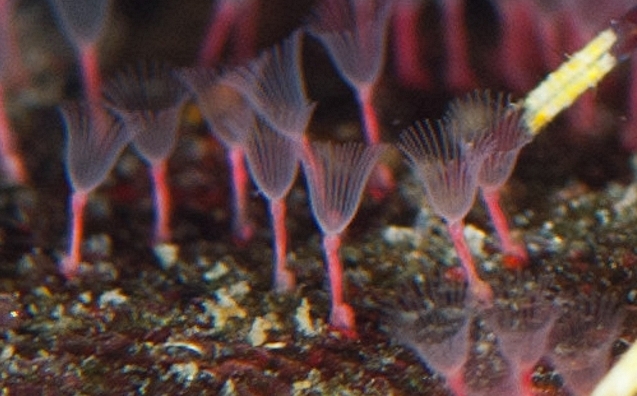Kingdom Animalia
Phylum Cnidaria
Class Anthozoa
Order Ceriantharia
Family Cerianthidae
Genus Pachycerianthus
Species P. fimbriatus
Binomial name : Pachycerianthus fimbriatus
Common Name : Burrowing anemone
I found this spectacular animal in the high inter-tidal zone, quite fresh. Not sure how or why it was where it was… it seems intact and undisturbed. Regardless it deserves to be documented, and I have frozen it so the students can study it later.
It appears to be a Lopholithodes mandtii. Puget sound King Crab.
Note: DO NOT COLLECT THIS CRAB! It is uncommon in Puget Sound/Straits and the Washington Fish and Wildlife dept. lists it as a protected species. Adults come up shallower to breed in late winter and spring. This is one of the largest crabs on the Pacific Coast of the 48 states. Carapace width can be up to 30 cm or more. It feeds on sea urchins and other echinoderms, has been observed eating sea anemones. Chelae are surprisingly cuplike, and lined with teeth and setae . Juveniles are a bright orange with prominent tubercles on the carapace, and may occasionally be found under rocks at extremely low tide. (http://www.wallawalla.edu/academics/departments/biology/rosario/inverts/Arthropoda/Crustacea/Malacostraca/Eumalacostraca/Eucarida/Decapoda/Anomura/Family_Lithodidae/Lopholithodes_mandtii.html)
The following classification is based on that of the Animal Diversity Web:
 On October 24, 2011, Ryan Murphy took a picture of a coonstripe shrimp (you can see part of its yellow leg showing in this blow-up). In his photo background, he also captured by chance the first record of this species for the Race Rocks Taxonomy files. See this file explaining the significance of this find.
On October 24, 2011, Ryan Murphy took a picture of a coonstripe shrimp (you can see part of its yellow leg showing in this blow-up). In his photo background, he also captured by chance the first record of this species for the Race Rocks Taxonomy files. See this file explaining the significance of this find.
Record in the Smithsonian Institute, from : http://collections.si.edu/search/record/nmnhinvertebratezoology_910698?q=set_name:%22Invertebrate+Zoology%22
Paratype for Stylaster parageus columbiensis Lindner & Cairns in Cairns & Lindner, 2011
Catalog Number: USNM 1096625
Collection: Smithsonian Institution, National Museum of Natural History, Department of Invertebrate Zoology
Ryan Murphy took these pictures of Stomatoca atra underwater at Race Rocks. It was identified by Dr. Anita Brinckmann-Voss.
This file is provided as part of a collaborative effort by the students, faculty, staff and volunteers of Lester B. Pearson College.
See this link for other hydroids: https://www.racerocks.ca/tag/hydroid/
This is a tentative identification . We would welcome confirmation or correction.
| Domain | Eukarya |
| Kingdom | Animalia |
| Phylum | Cnidaria |
| Class | Anthozoa |
| Order | Actinaria |
| Family | Metridiidae |
| Genus | Metridium |
| Species | senile |
| Common Name: | Short Plumose Anemone |
Note: Metridium farcimen is the Giant Plumose Anemone
| Image by Garry Fletcher,September 7, 2011 |
| This is the first image taken of this variety of gooseneck barnacle at Race Rocks. On the tidal energy generator which was removed in 2011. Two clumps of these barnacles were collected from a join in the housing materials. In Lamb and Hanby, Marine Life of the Pacific Northwest, they state the following:“—Nakwakto goose-neck barnacle, a large and colourful variation of the goose neck barnacle found inlNakwakto Rapids, Slingsby Channel, BC. The glorious red colour is actually the hemoglobin in the barnacle’s blood. The blood is obvious in subtidal specimens like these which do not have black pigment that which protects the sun-exposed populations inhabiting shallow or intertidal zones. Familiar to an ever-increasing number of recreational divers, the unique and isolated population must be preserved via a No-Take Marine Protected Area.”
Link to the regular taxonomy and image file for the more common Pollicepes polymerus |
Domain Eukarya
Kingdom Animalia
Phylum Arthropoda
Order Thoracia
Suborder Lepadomorpha
Family Scalpellidae
Genus Pollicepes
Species polymerus
Common Name: Goose neck Barnacle Nakwakto (variety)
| Other Members of the Phylum Arthropoda at Race Rocks |
and Image File |
 The Race Rocks taxonomy is a collaborative venture originally started with the Biology and Environmental Systems students of Lester Pearson College UWC. It now also has contributions added by Faculty, Staff, Volunteers and Observers on the remote control webcams. The Race Rocks taxonomy is a collaborative venture originally started with the Biology and Environmental Systems students of Lester Pearson College UWC. It now also has contributions added by Faculty, Staff, Volunteers and Observers on the remote control webcams.
September 2011- Ryan Murphy |
These fish are not often seen by divers at Race Rocks, but that may be more a result of the cryptic coloration.
| Kingdom: | Animalia |
| Phylum: | Chordata |
| Class: | Actinopterygii |
| Order: | Perciformes |
| Family: | Stichaeidae |
| Genus: | Chirolophis |
| Species: | C. decoratus (Jordan & Snyder, 1902) |
| Return to the Race Rocks Taxonomy Index | |
Garry Fletcher went with Phil and Marilyn Lambert and Peter McAuliffe to Race Rocks for The Metchosin Bioblitz 2011. Most of the marine Algae and Invertebrates recorded came from Phil’s list. http://metchosinbiodiversity.com/2011results.php